OWC miniStack STX
Support Manual
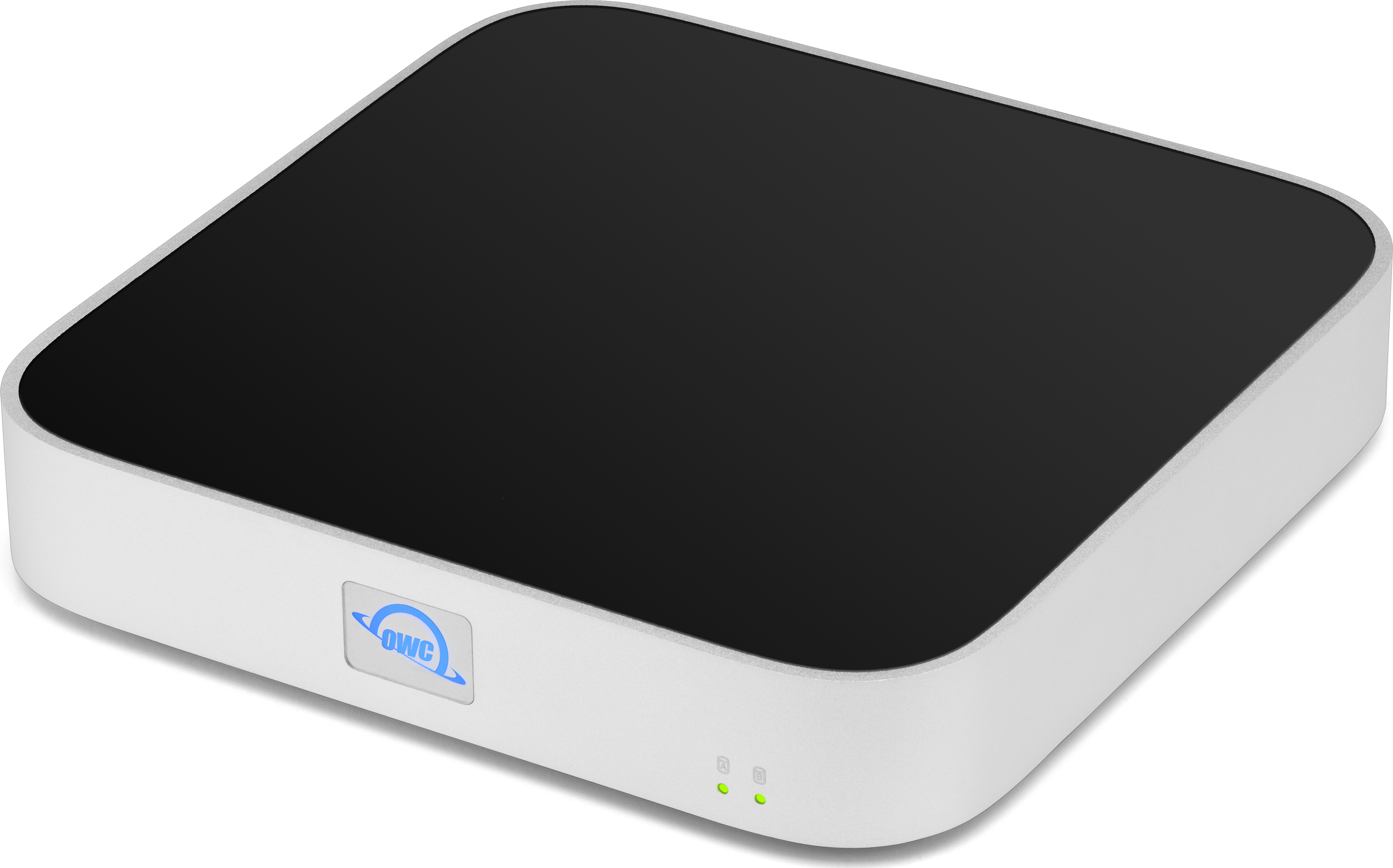
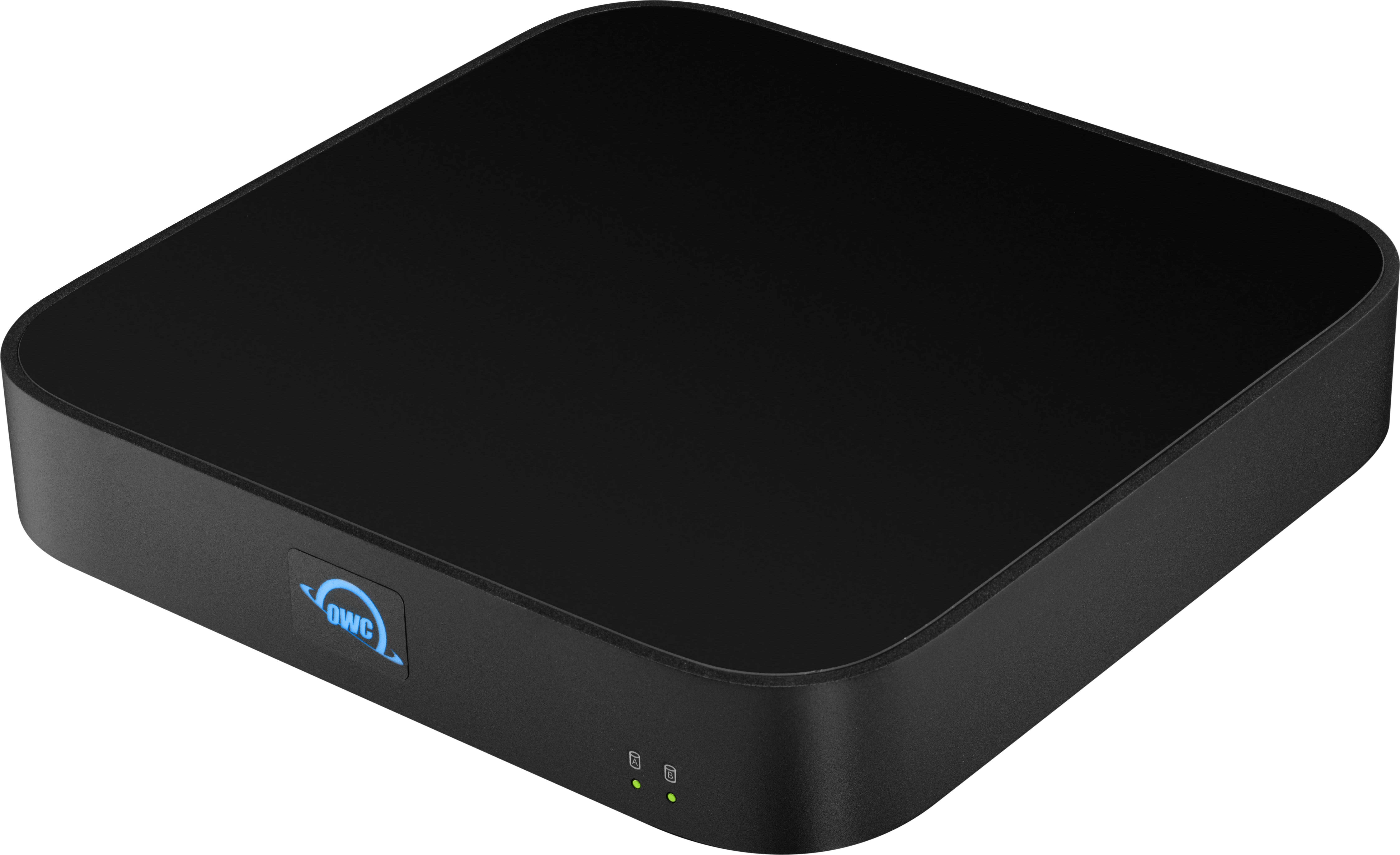
Introduction
1.1 System Requirements
Operating System & Hardware
- Works with any USB4 or Thunderbolt (USB-C) equipped:
- Mac: macOS 10.14 or later
- PC: Windows 10 or later
- Linux: current version recommended
- iPad: iPadOS 13 and later (requires a Thunderbolt connection)
- iPhone: current version recommended
- ChromeOS: current version recommended
- Android: current version recommended
- Other: Works as a USB-C hub with SATA storage on any Mac, PC, or tablet with a USB Type-A port (USB-C to USB-A adapter sold separately)
Supported Drives
- 3.5"/2.5" SATA HDDs/SSDs (SATA drives connect via USB protocol)
- NVMe M.2 SSD with a M-key connector and 2280 form factor
1.2 Package Contents
- (1) OWC miniStack STX
- (1) Thunderbolt 4 cable
- (1) Power supply
- (1) Power cable
- (1) Getting Started QR insert card
1.3 Front View
A. (1) Power Status LED
- Power Connection = Solid White
- Data Connection = Solid Blue
B. (1) SATA Drive Status LED (A)
- Power & Data Connection = Solid Green (NOTE: Initially solid green, the LED light will turn off after a few moments of connection)
- Drive Activity = Flashing Green
C. (1) NVMe Drive Status LED (B)
- Power & Data Connection = Solid Green
- Drive Activity = Flashing Green


1.4 Back View
D. (4) OWC ClingOn-ready cable stabilizer mount – Affix ClingOn to help prevent accidental cable disconnections (sold separately)
E. (3) Thunderbolt (USB-C) ports - Connect Thunderbolt devices.
F. (1) Thunderbolt (USB-C) host port - Connect a compatible host.
G. (1) DC IN Power Port - Connect the power cable to power the device
H. (1) Kensington Security slot – Attach a Kensington Security lock.


Getting Started
2.1 Device Setup
This section describes the process of setting up the OWC miniStack STX if purchased with pre-installed drives. The OWC miniStack STX is available with several assembly and formatting variations.
- If the OWC miniStack STX is assembled with (1) SATA HDD:
- The SATA HDD is formatted as HFS+ for Mac.
- If the OWC miniStack STX is assembled with (1) NVMe M.2 SSD:
- The NVMe M.2 SSD is formatted as APFS for Mac.
- If the OWC miniStack STX is assembled with (1) SATA HDD and (1) NVMe M.2 SSD:
- The SATA HDD is formatted independently as HFS for Mac, and the NVMe M.2 SSD is formatted independently as APFS+ for Mac.
Apple OWC miniStack STX Setup
- Connect the power cable into the power adapter. Plug the power cable into the OWC miniStack STX DC IN power port located on the back and into a power outlet.
- The OWC miniStack STX is configured as a Mac-formatted device allowing seamless plug-and-play experience between Mac and iPad systems. Connect the included Thunderbolt cable into the Host Thunderbolt (USB-C) port located on the back of the OWC miniStack STX and into a Mac or iPad. The Drive Status LEDs will illuminate a solid green for each drive type installed.
Windows, Chrome, and Android miniStack STX Setup
- Connect the power cable into the power adapter. Plug the power cable into the OWC miniStack STX DC IN power port located on the back and into a power outlet.
- Using the OWC miniStack STX with either a Windows, ChromeOS, or Android operating system requires the pre-installed drives to be reformatted before they can be used. The following options will allow the Mac-formatted OWC miniStack STX to work as a Windows, ChromeOS, or Android formatted device.
- Reformat the Mac-formatted device using OWC Drive Guide for Windows. This application is only available for devices assembled and shipped from OWC.
- Download OWC Drive Guide for Windows to begin the process of reformatting the OWC miniStack STX to work with Windows.
- Please consult the OWC Drive Guide Support Manual for instructions.
- The Mac formatted OWC miniStack STX can be used in Windows through the purchase and installation of OWC MacDrive11. OWC MacDrive11 allows access to Mac-formatted drives in Windows without reformatting.
- Please visit OWC MacDrive Product Details or OWC MacDrive Support for more information.
- ChromeOS and Android users should consult the support article "OWC Drive Setup for Windows, Chrome, and Android Platforms" for instructions regarding reformatting the OWC MiniStack STX to work with ChromeOS or Android operating systems.
2.2 Assembly Steps
This section describes the process of installing SATA and NVMe drives into the OWC miniStack STX. The images and descriptions may vary slightly between this manual and the unit shipped. OWC offers two colored versions of the miniStack STX (Black and Silver). The following assembly instructions highlight drive installation into a Black miniStack STX. However, the same instructions can be used for installing a drive into a Silver miniStack STX.
NOTE: An installation video is available by visiting the Support Guide page for the OWC miniStack STX (start.owc.com/ministackstx)
Opening the miniStack STX
1. Place the miniStack STX upside-down and remove the four screws on the bottom side of the outer case.

2. While gripping the miniStack place it right-side up with the OWC logo facing forward. Slowly life the top case off from back to front.
NOTE: There is a cable clipped inside to the outer case and connected near the NVMe M.2 SSD circuit board. Opening slowly helps prevent accidentally disconnecting the cable.
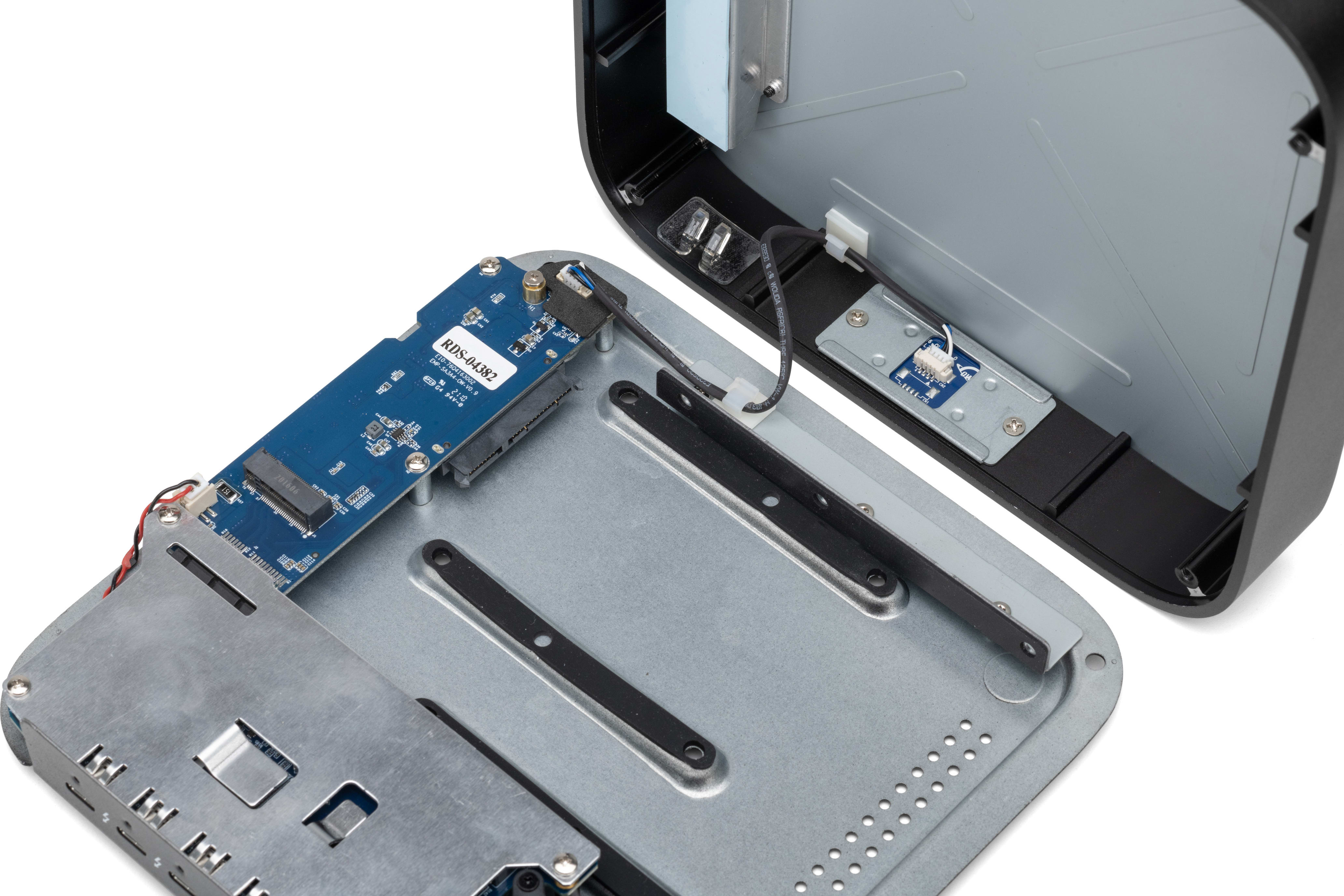
3. Carefully remove the cable from the routing clip. Then carefully disconnect the cable by pulling on the cable connector near the NVMe M.2 SSD circuit board. Please do not directly pull on the cable.
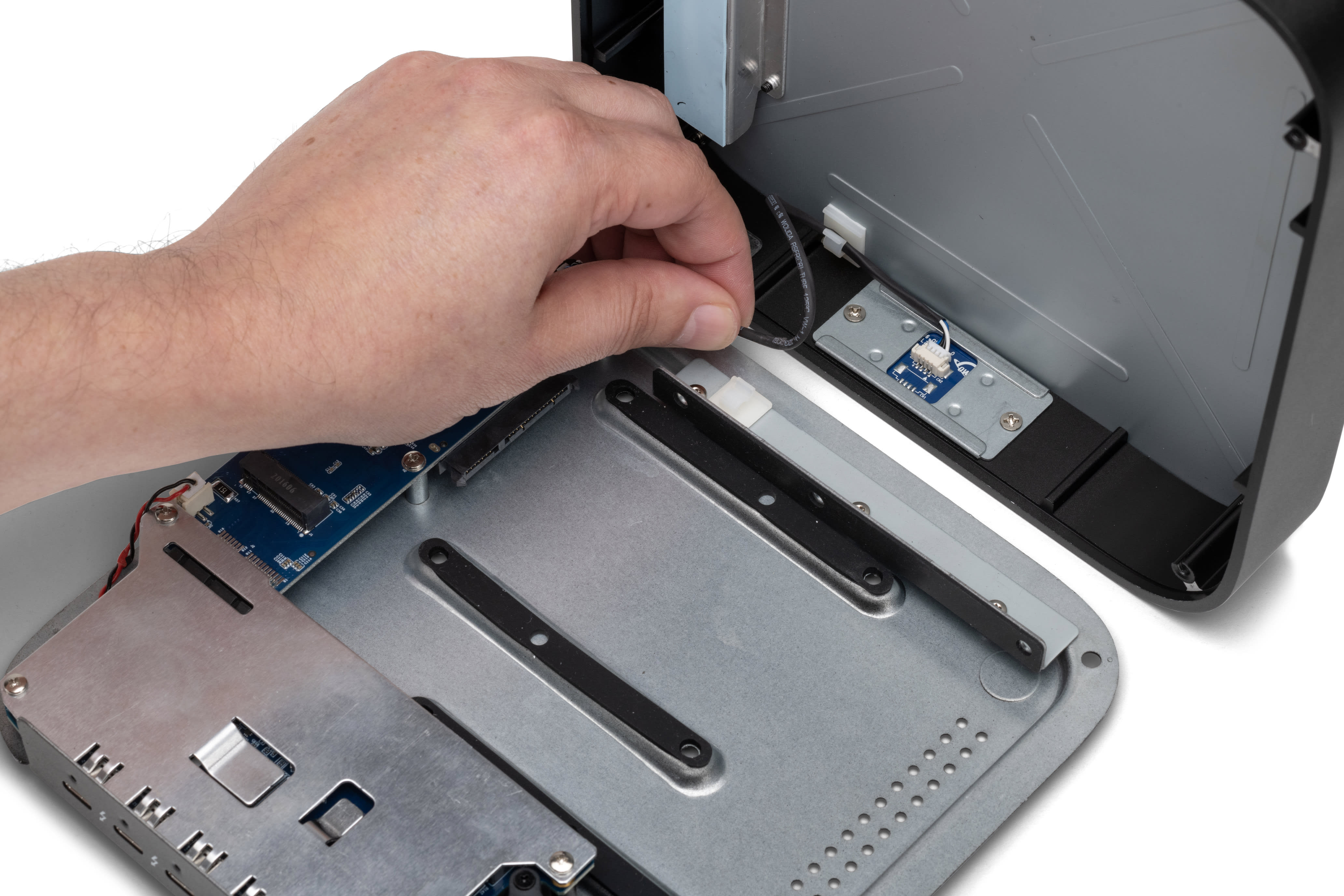
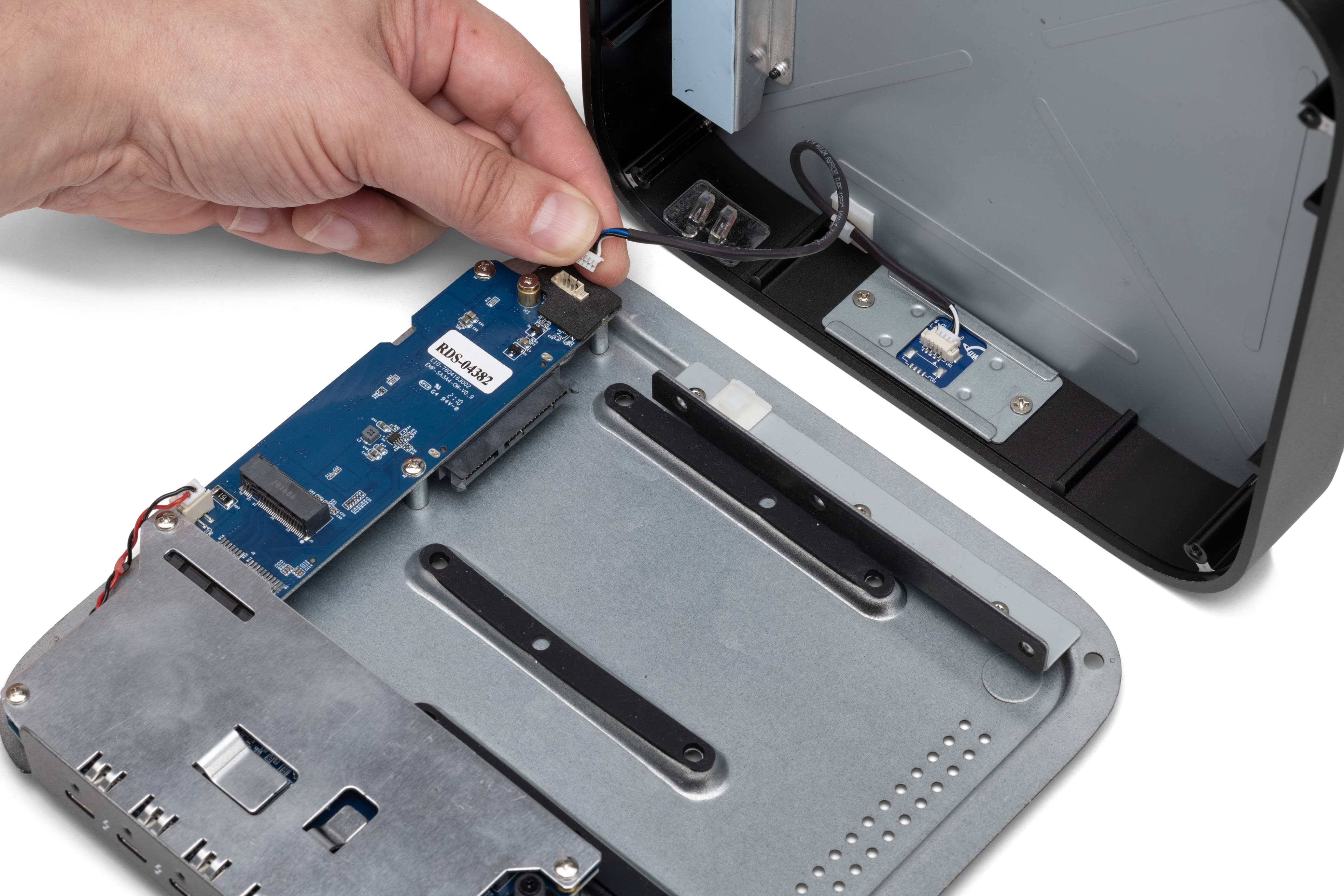
Drive Installation
3.5-Inch Drive Installation
- Place the 3.5-Inch drive into the chassis and connect into the SATA connector on the circuit board. Make sure the drive is fully seated.
- Secure the drive from the inside using the included HDD Mounting Screws.
- Turn over the miniStack and further secure the drive using the HDD Mounting Screws.

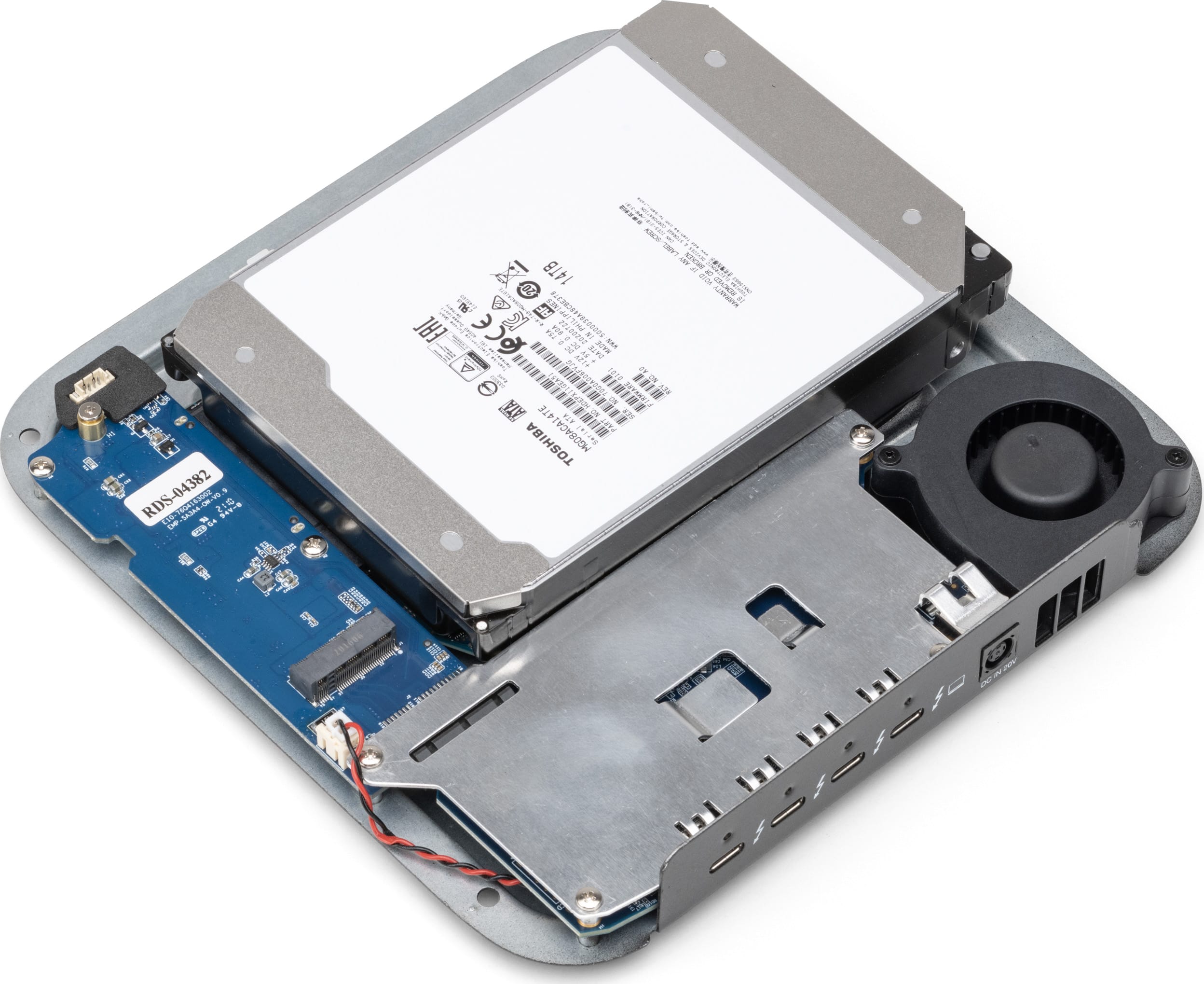
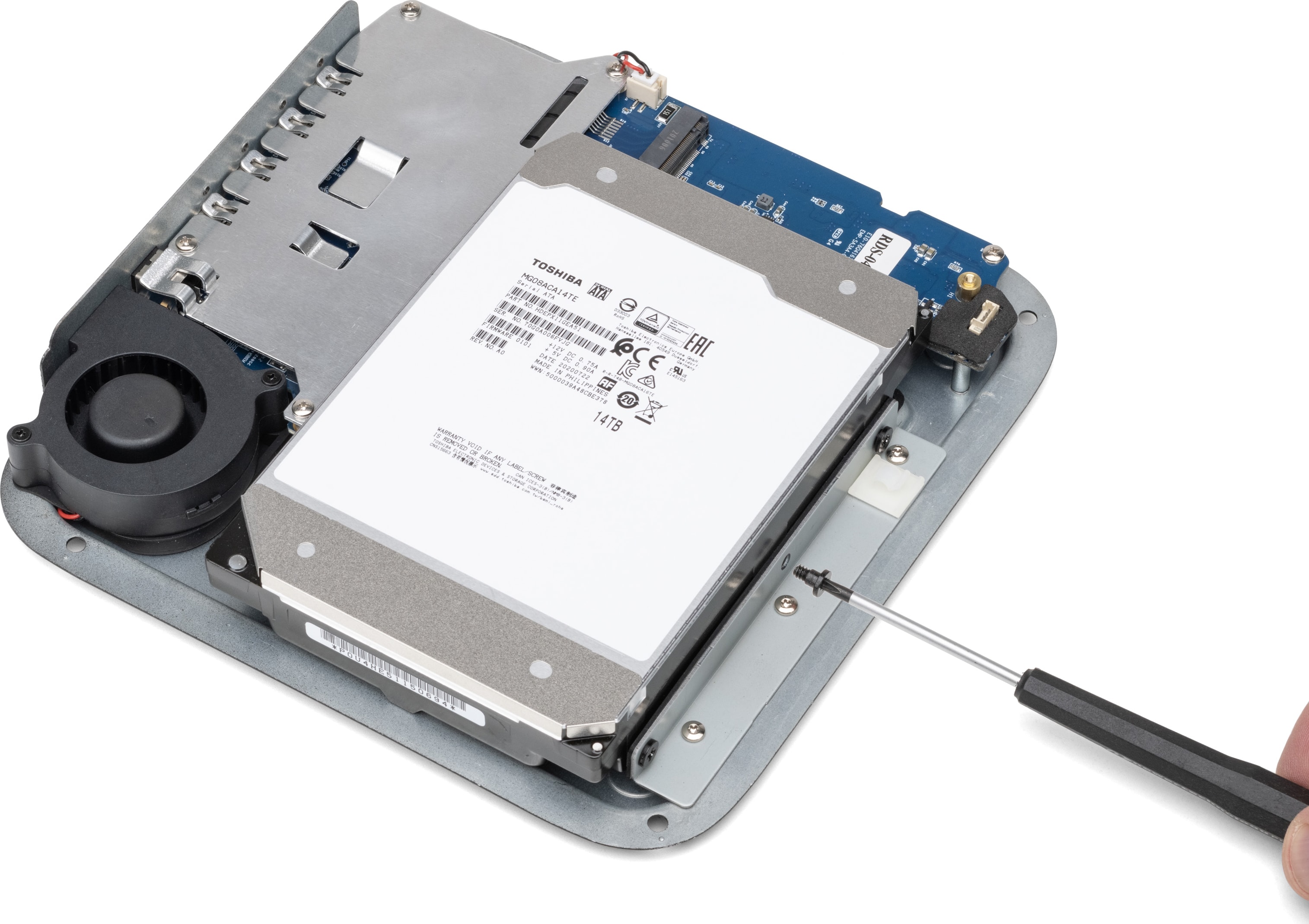
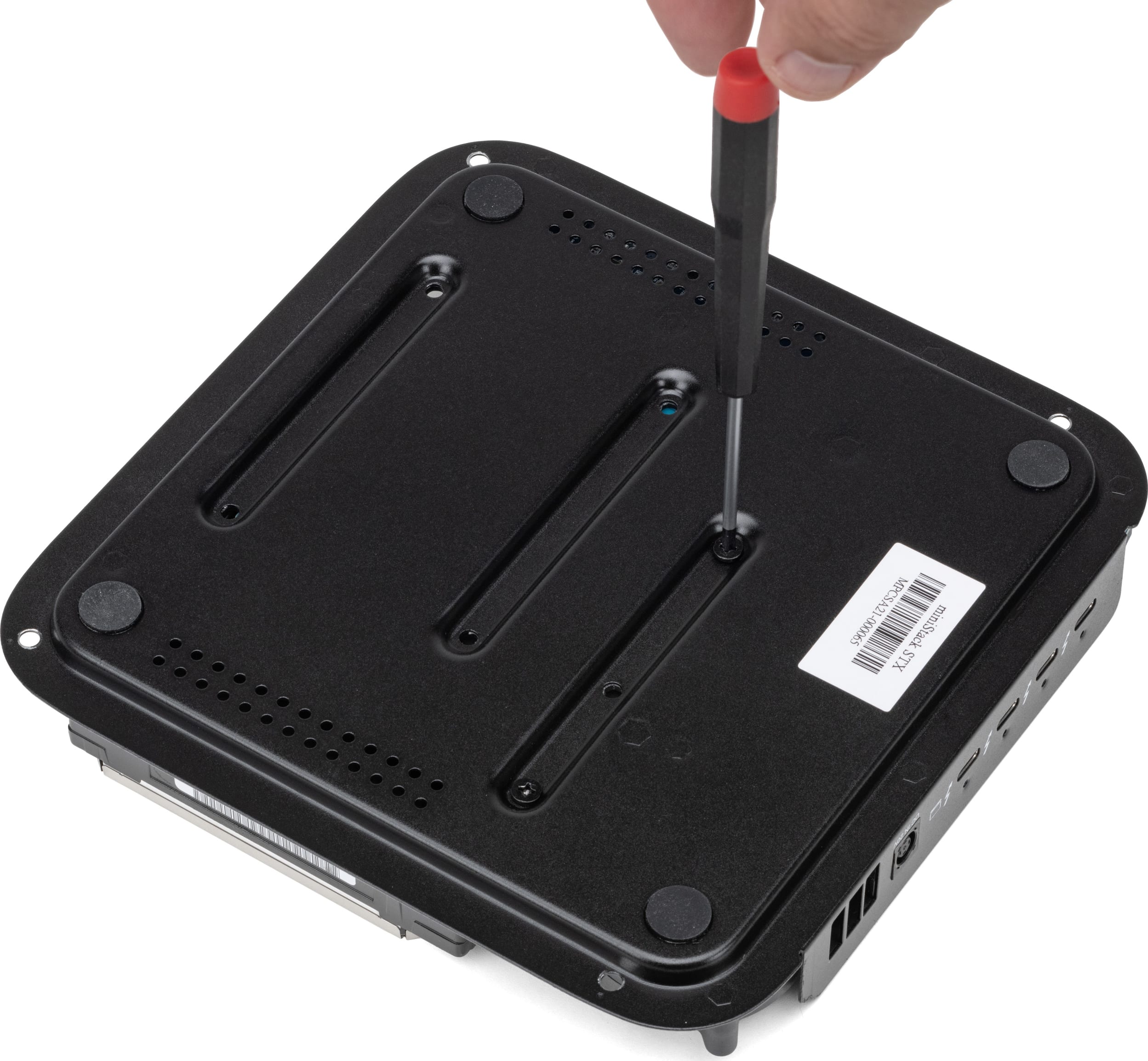
2.5-Inch Drive Installation
- Place the 2.5-Inch drive into the chassis and connect into the SATA connector on the circuit board. Make sure the drive is fully seated.
- Turn over the miniStack and further secure the drive using the SSD Mounting Screws.
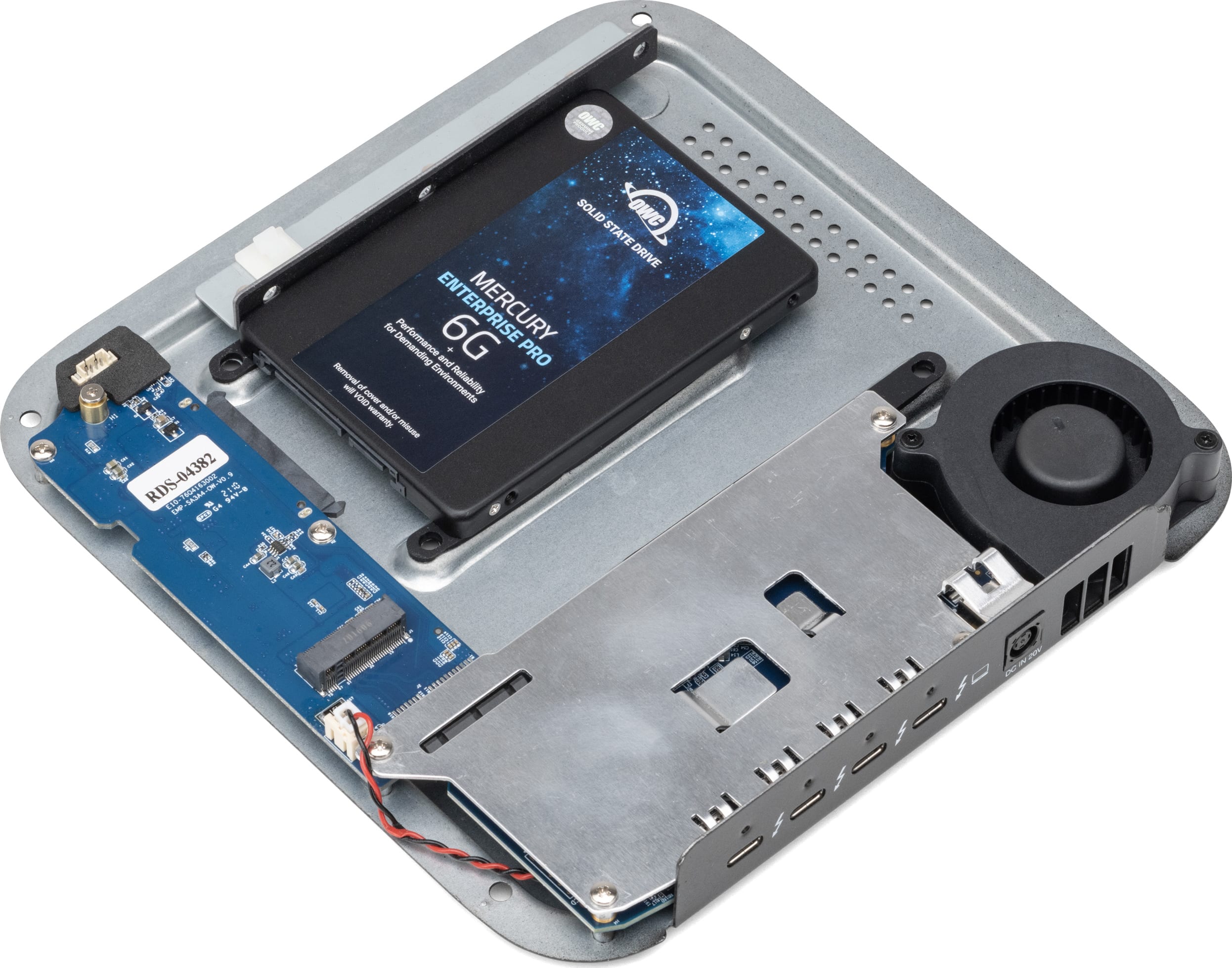
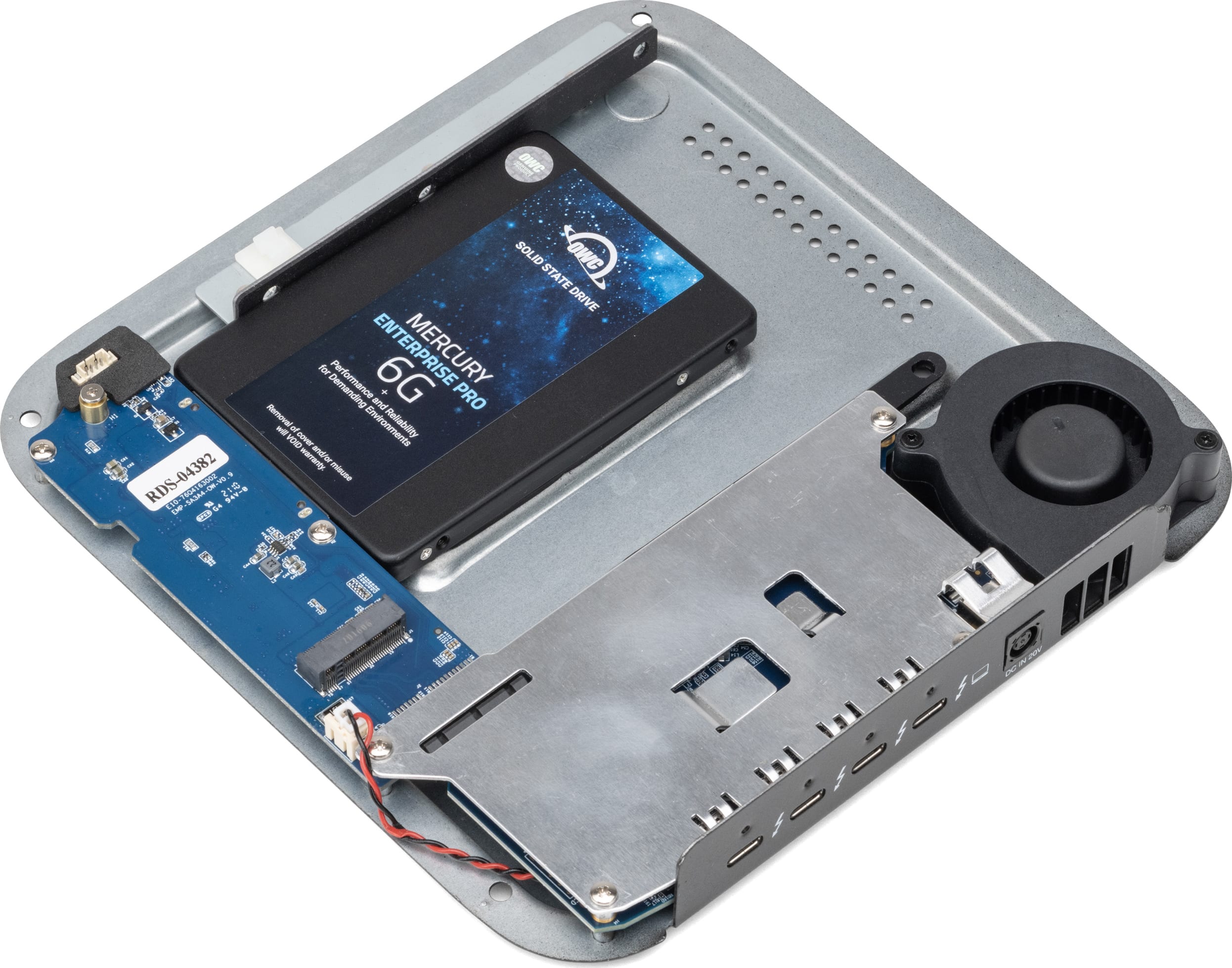
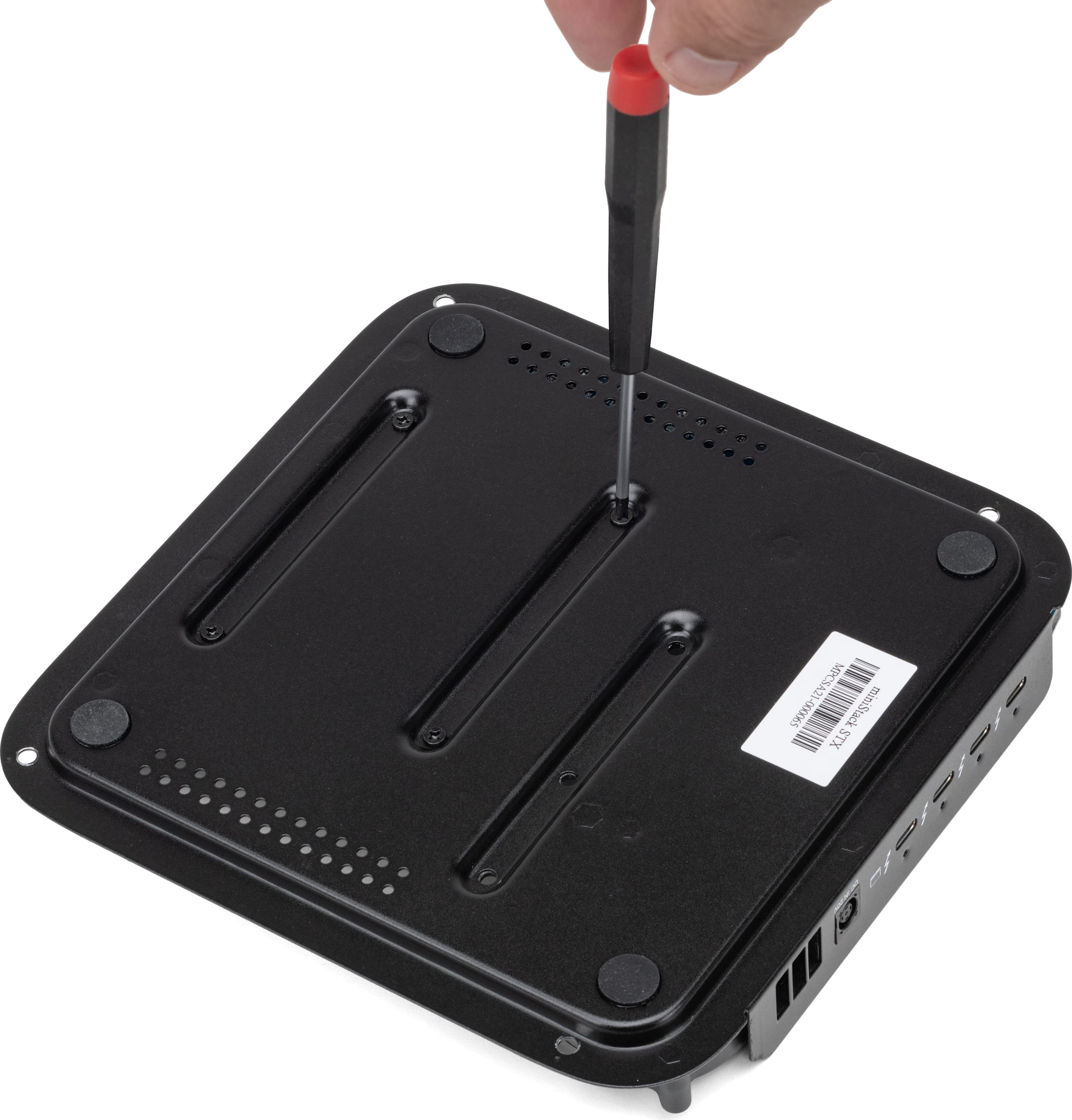
NVMe Drive Installation
- Remove the NVMe M.2 SSD mounting screw and insert a NVMe M.2 SSD fully into the connector at a slight angle.
- Press the NVMe M.2 SSD down so the drive’s notch fits around the mounting post.
- Secure the drive by using the NVMe M.2 SSD mounting screw that was first removed.
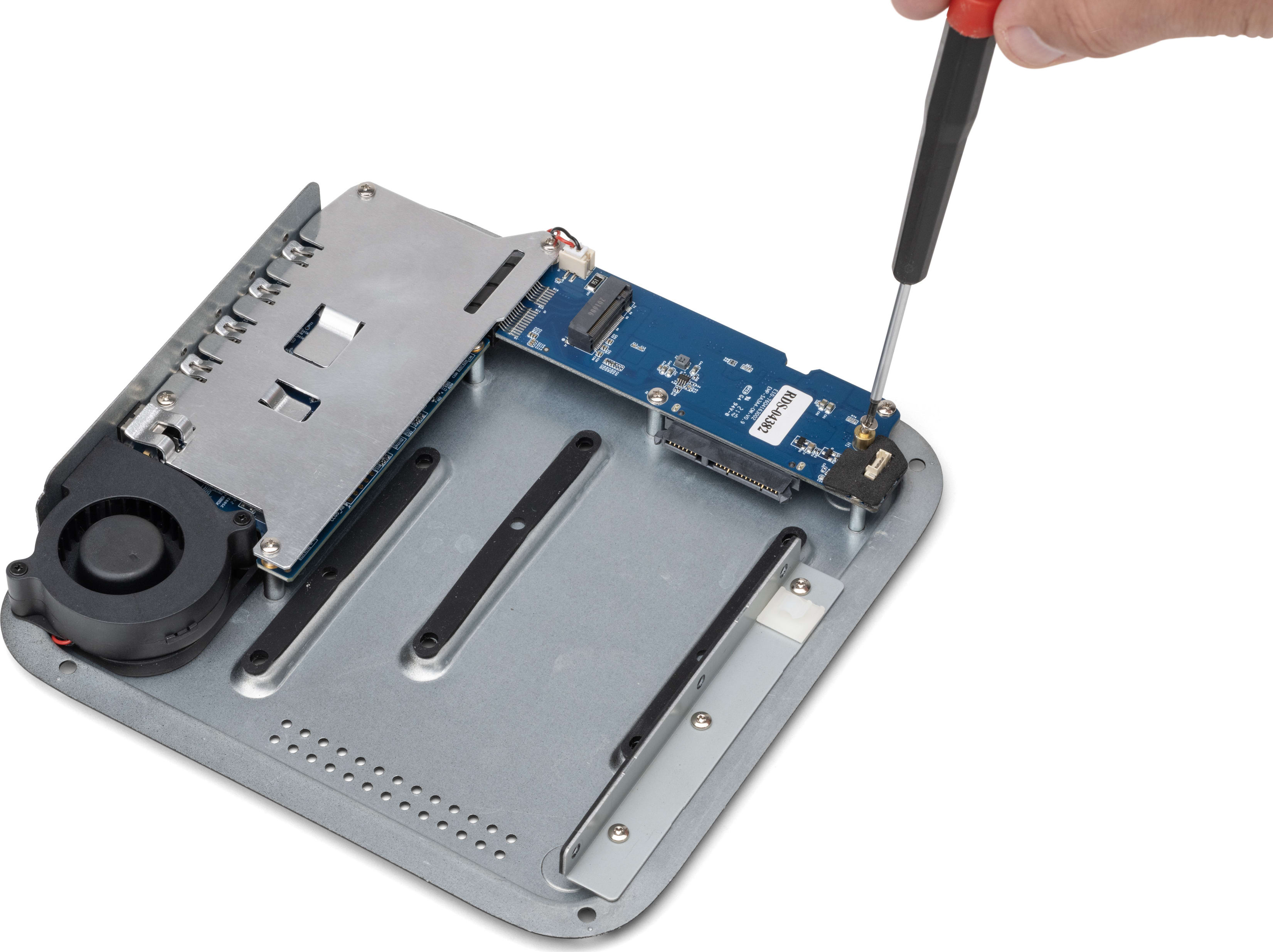
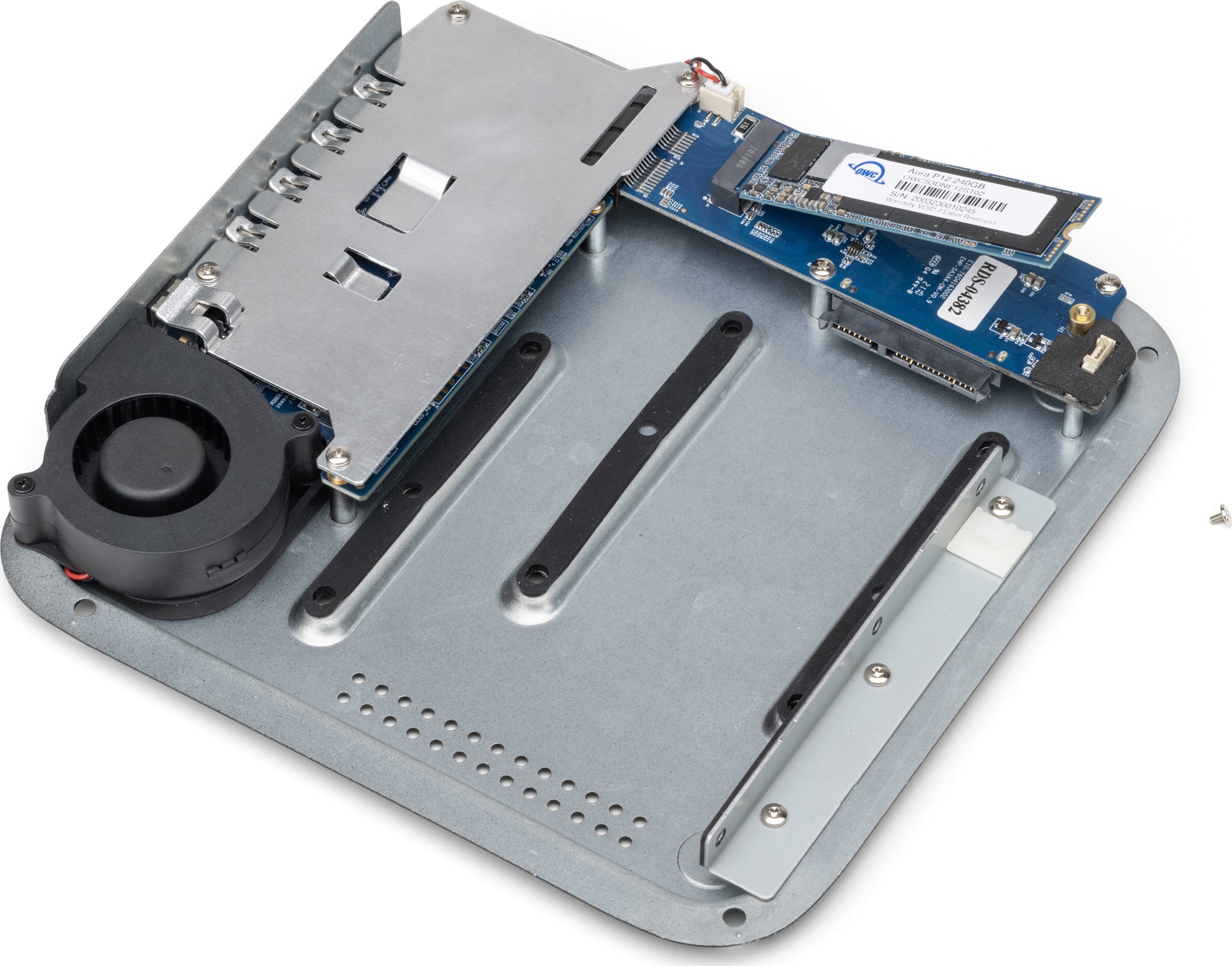
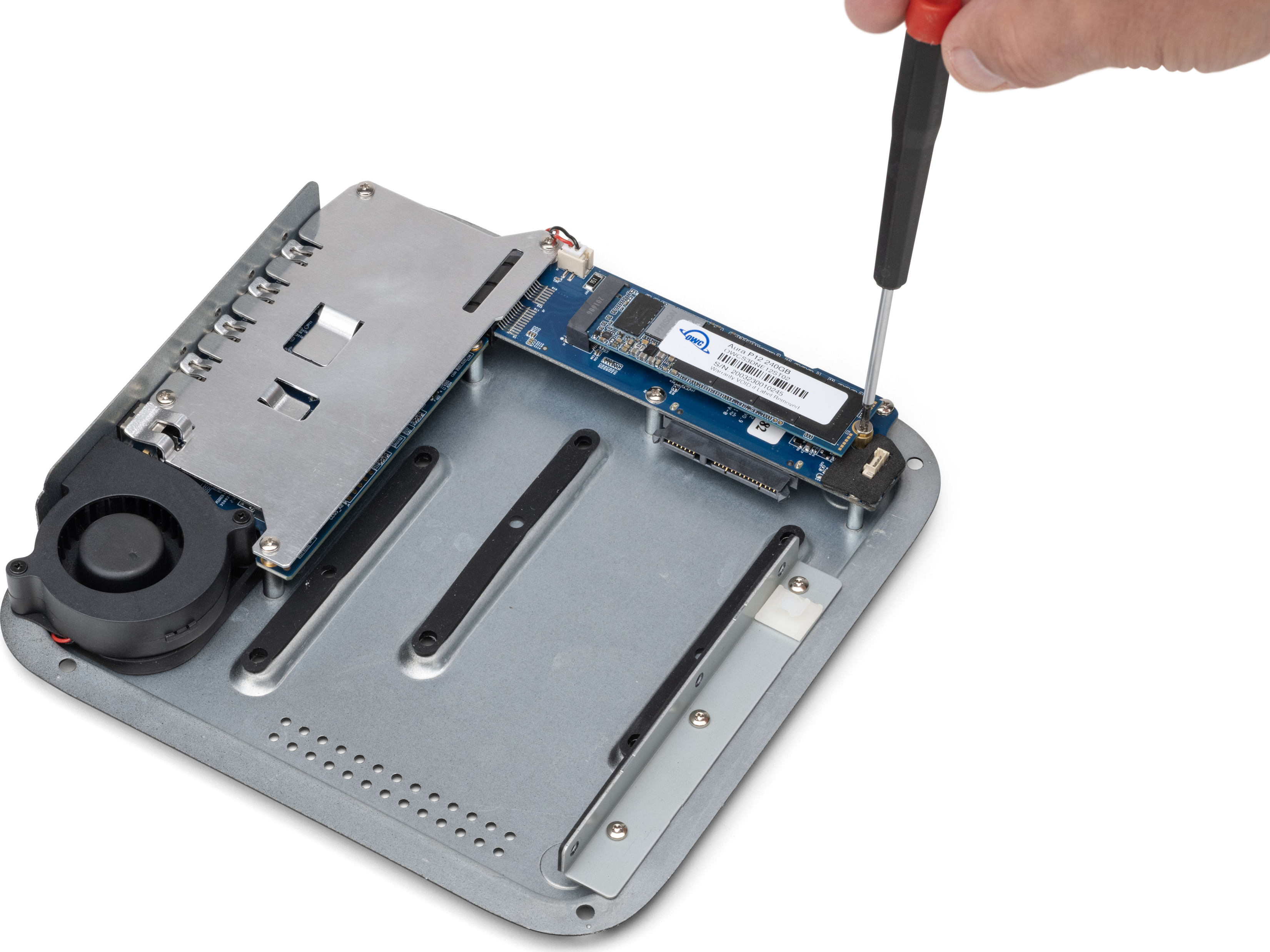
Closing the miniStack STX
1. Carefully place the cable back into the cable routing clip. Then carefully connect the cable back into the connection near the NVMe M.2 SSD circuit board.
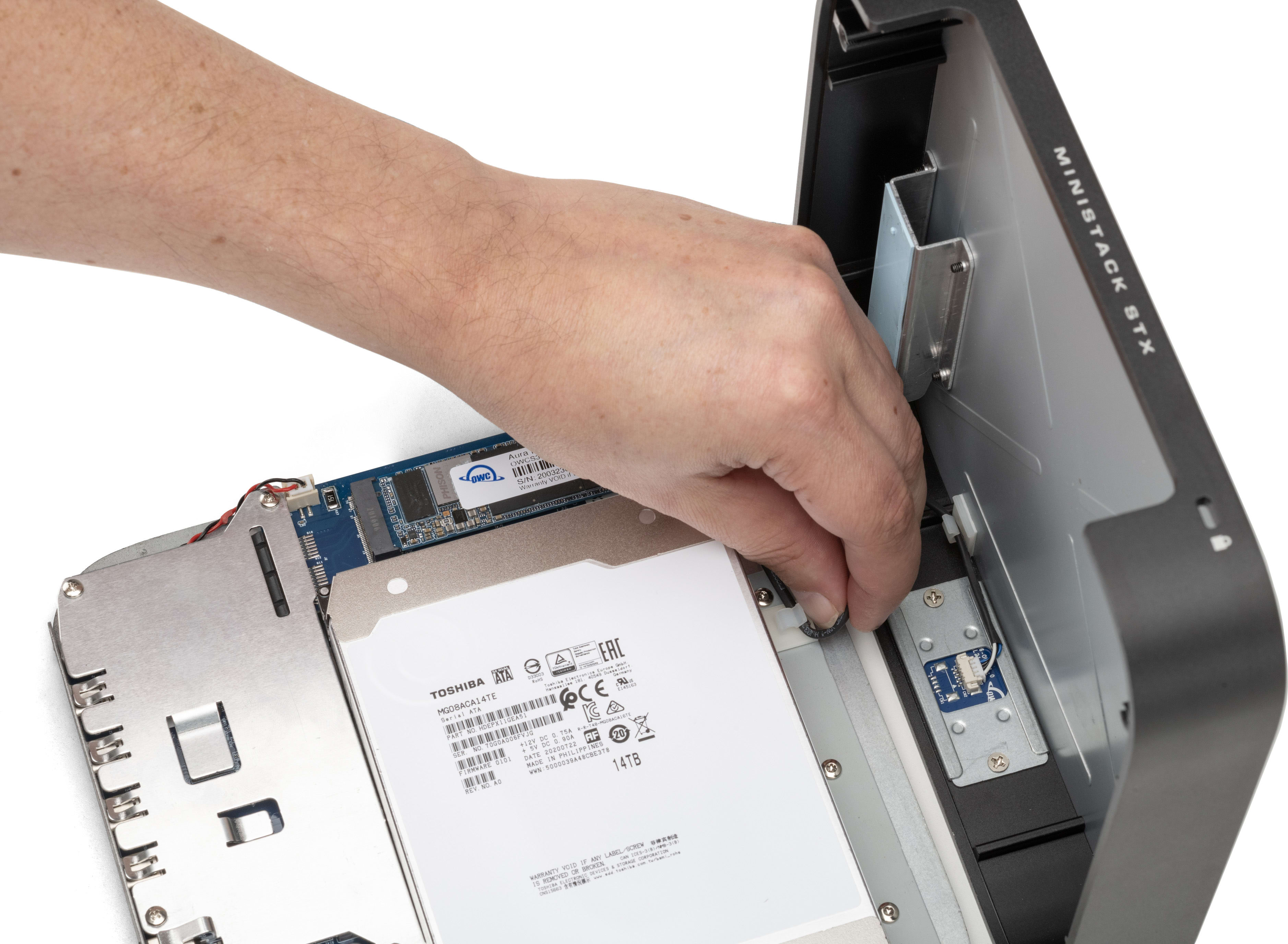
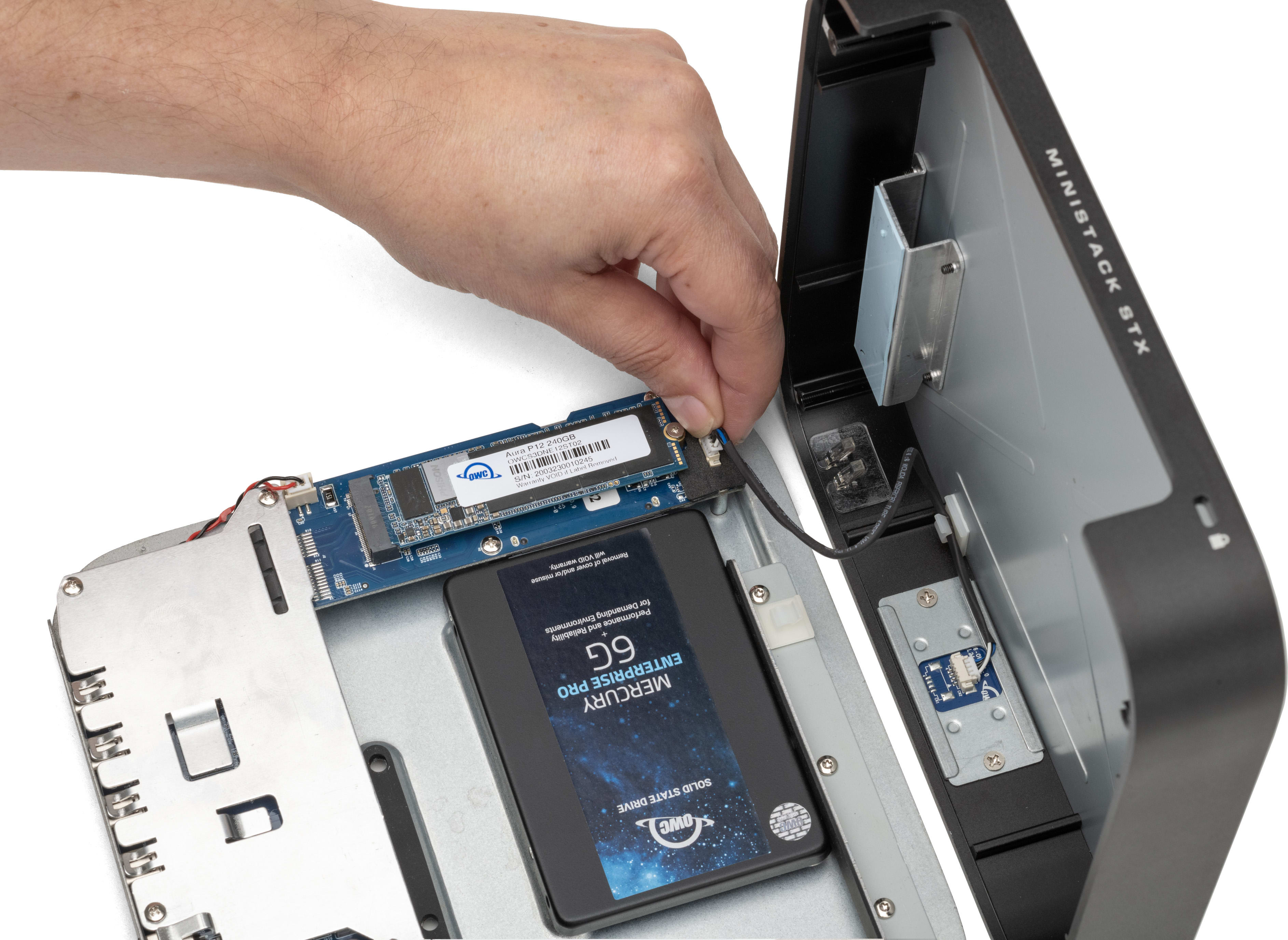
2. Place the top case back on the miniStack from front to back and while gripping, flip the unit upside down. Secure the miniStack by using the four removed case screws.
3. The installed drives are ready to be formatted. Please visit go.owc.com/storage/formatting for formatting options.
Device Management
3.1 OWC Disk Performance
As of Windows 10 v. 1809 the default Disk Removal Policy is ‘Quick removal’ instead of ‘Better performance’.
NOTE: OWC storage solutions that are experiencing slow read/write speeds should consider checking and changing the Windows disk removal policy. Changing from "Quick removal" to "Better performance" can increase disk performance. OWC offers the application OWC Disk Performance to help change the Disk Removal Policy. Changing from "Quick removal" to "Better performance" can also be changed manually.
Please review the support article Storage Solutions: OWC Disk Performance for more detail.
3.2 Manually Unmounting Volumes
To ensure no data is lost during normal use, always eject or unmount the corresponding volume(s) from the operating system before powering off and disconnecting the device. Unmounting options are provided below.
macOS
- Drag the icon for the device you wish to unmount to the trash can; OR
- Right-click the device icon on the desktop, then click “Eject”; OR
- Highlight the device on your Desktop and press Command-E.
Windows
- Windows 10 build 1809 (October 2018) or later:
- Eject the drive by clicking the ‘Show hidden items’ menu in the Taskbar, then clicking ‘Safely Remove Hardware and Eject Media’, and last select the ‘Eject’ option for this volume.
- Windows 10 build 1803 and earlier:
- Go to the System Tray (located in the lower right corner of your screen). Click on the “Eject” icon (a small green arrow over a hardware image).
- A message will appear, detailing the devices that the “Eject” icon controls, i.e., “Safely remove...” Click on this prompt.
- You will then see a message that says, “Safe to Remove Hardware.” It is now safe to disconnect the device from the computer.
3.3 Usage Notes
- Mac Users: A software driver is required to enable Apple Super Drive, Apple USB Keyboard, and for charging iPad generations 1, 2 and 3. This driver is included in the OWC Dock Ejector software download package. If your SuperDrive doesn't respond when connected to an external display or USB hub, connect your SuperDrive to a USB port directly on your Mac.
- NVMe SSDs with a heatsink will not fit and are not supported.
- Thunderbolt devices like miniStack STX are not supported for use with legacy Thunderbolt 1 and 2 machines via Apple's Thunderbolt adapter. Use with a Mac, PC, or device equipped with USB-A only requires a USB-C to USB-A adapter cable (available separately). Up to two external displays supported by Intel Mac machines over Thunderbolt connection. Apple silicon M1 and M2 Macs support one external display over Thunderbolt.
- Display support depends upon host. Please review the display specifications of the specific host system to determine the maximum supported resolution, refresh rate, color depth, and number of external displays over Thunderbolt or USB.
- NVMe SSD usage requires a Thunderbolt (USB-C) host connection with a compatible system running macOS 11.x or later. USB host connectivity provides SATA drive use only, and limits additional miniStack STX ports to USB connectivity only.
- Works with Thunderbolt 4, Thunderbolt 3, USB4, and USB3 host computers and mobile devices. Thunderbolt/Thunderbolt 2 host connection is not supported and will only connect over USB-A.
- With a USB host (such as a USB-C equipped MacBook, iPad, Chromebook, Android device, or PC), this device works as a USB hub. Bandwidth is reduced to USB speeds, Thunderbolt devices are not supported, and additional functionality will vary depending upon the host port's capabilities.
- With a USB-C host, displays and power delivery support will depend upon the host port's capabilities.
- With a USB-A host, displays and power delivery are not supported. Requires a USB-C to USB-A adapter cable (available separately).
- A USB host connection is required for Mac systems running macOS 10.14 or 10.15.
- NVMe SSD usage requires a Thunderbolt (USB-C) host connection with a compatible system running macOS 11.x or later. USB host connectivity provides SATA drive use only, and limits additional miniStack STX ports to USB connectivity only.
- SATA drives connect via USB protocol.
- Use of miniStack STX with a USB-C or USB-A host allows use of the miniStack STX’s SATA drive only and use of its ports for USB accessories only.
- Some internal drives may not support LED status function.
- UltraStudio Recorder 3G is not compatible. System Report will show the device being connected; however, the driver won’t load which doesn’t allow for use of the device. UltraStudio Recorder 3G works properly when directly connected to a system.
Support Resources
4.1 Troubleshooting
- If your computer does not recognize the OWC miniStack STX when it is connected:
- Verify the Thunderbolt cable is securely connected between the OWC miniStack STX and computer.
- Connect the OWC miniStack STX and computer with a different Thunderbolt cable.
- Connect the OWC miniStack STX to a different computer.
- Windows users experiencing slow read/write speeds should consider checking and changing the Windows disk removal policy. Please review the support article Storage Solutions: OWC Disk Performance for additional details.
- We are very sorry If issues continue to occur. Please know that OWC support is here to help. Contact information for our support can be found in section 4.4 "Contacting Support". Please have your serial number ready which is located on the bottom of the OWC miniStack STX and printed on the original packaging.
4.2 Online Resources
Support Articles:
- OWC Disk Performance Support Article
- Drive Formatting Support Article
- Data Migration Support Article
- OWC Drive Setup for Windows, Chrome, and Android Platforms Support Article
Support Guide Pages:
Support Manuals:
Installation Videos:
Downloads:
Product Pages:
4.3 About Data Backup
To ensure that your files are protected and to prevent data loss, we strongly suggest that you keep two copies of your data: one copy on your OWC miniStack STX and a second copy on either your internal drive or another storage medium, such as an optical backup, or on another external storage unit. Any data loss or corruption while using the OWC miniStack STX is the sole responsibility of the user, and under no circumstances may OWC, its parents, partners, affiliates, officers, employees, or agents be held liable for loss of the use of data including compensation of any kind or recovery of the data.
4.4 Contacting Support
4.5 About This Manual
The images and descriptions may vary slightly between this manual and the unit shipped. Functions and features may change depending on the firmware version. The latest product details and warranty information can be found on the product web page. OWC’s Limited Warranty is not transferable and
General Use Precautions
- To avoid damage, do not expose the device to temperatures outside the following ranges:
- Environmental (Operating)
- Temperature (ºF): 41º — 95º
- Temperature (ºC): 5º — 35º
- Environmental (Non-Operating)
- Temperature (ºF): -4º — 140º
- Temperature (ºC): -20º — 60º
- Environmental (Operating)
- Always unplug the device from the electrical outlet if there is a risk of lightning or if it will be unused for an extended period-of-time. Otherwise, there is an increased risk of electrical shock, short-circuiting, or fire.
- Protect your device from excessive exposure to dust during use or storage. Dust can build up inside the device, increasing the risk of electrical shock, short-circuiting, or fire.
- Do not block any ventilation openings on the device. These help to keep the device cool during operation. Blocking the ventilation openings may increase the risk of electrical shock, short-circuiting, or fire.
Safety Precautions
- Use proper anti-static precautions when handling this device. Failure to do so can increase the risk of electrical shock or short-circuiting.
- Never expose your device to rain, or use it near water, or in damp wet conditions. Never place objects containing liquids on the device, as they may spill everywhere and into the openings. This will increase the risk of electrical shock, short-circuiting, fire, or personal injury.
- To avoid any risk of electrical shock, short-circuiting, fire, or dangerous emissions, never insert any metallic object into the device.
- Please cease use of the device and contact OWC Support if it appears to be malfunctioning.
Terms & Conditions of Sale
Warranty
OWC’s products are subject to OWC’s Terms & Conditions of Sale located at Terms of Sale or other applicable terms. The OWC miniStack STX if purchased with out drives comes with a 1-Year Limited Warranty. The OWC miniStack STX if purchased with drives comes with a 3-year Limited Warranty. Additional warranty information can be viewed by visiting Hardware Warranties.
Changes
The material in this document is for information purposes only and subject to change without notice. While reasonable efforts have been made in the preparation of this document to assure its accuracy, OWC, its parent, partners, affiliates, officers, employees, and agents assume no liability resulting from errors or omissions in this document, or from the use of the information contained herein. OWC reserves the right to make changes or revisions in the product design or the product manual without reservation and without obligation to notify any person of such revisions and changes.
FCC Statement
Warning! Modifications not authorized by the manufacturer may void the user’s authority to operate this device.
NOTE: This equipment has been tested and found to comply with the limits for a Class B digital device, pursuant to Part 15 of the FCC Rules. These limits are designed to provide reasonable protection against harmful interference in a residential installation. This equipment generates, uses and can radiate radio frequency energy and, if not installed and used in accordance with the instructions, may cause harmful interference to radio communications. However, there is no guarantee that interference will not occur in a particular installation. If this equipment does cause harmful interference with radio or television reception, which can be determined by turning the equipment off and on, the user is encouraged to try to correct the interference by one or more of the following measures:
- Reorient or relocate the receiving antenna.
- Increase the separation between the equipment and receiver.
- Connect the equipment to an outlet on a circuit different from that to which the receiver is connected.
Copyrights and Trademarks
© 2023 Other World Computing, Inc. All rights reserved. miniStack, OWC and the OWC logo are trademarks of New Concepts Development Corporation, registered in the U.S. and/or other countries. Mac and macOS are trademarks of Apple Inc., registered in the U.S. and other countries. Thunderbolt and the Thunderbolt logo are trademarks of Intel Corporation in the U.S. and/or other countries. Other marks may be the trademark or registered trademark property of their owners.
No part of this publication may be reproduced, stored in a retrieval system, or transmitted in any form or by any means, electronic, mechanical, photocopying, recording or otherwise, without the prior written consent of OWC.
Free Support Chat
Our free award-winning support team is ready to answer all of your questions. Technical support is available Monday - Friday: 9AM - 6PM. Customer Support & Sales is available Monday - Friday: 9AM - 6PM. Support is unavailable on U.S. Federal holidays. Talk to a human today.

 1-800-275-4576
1-800-275-4576